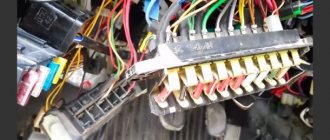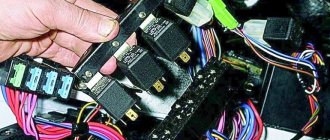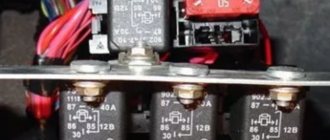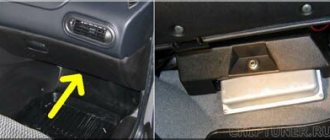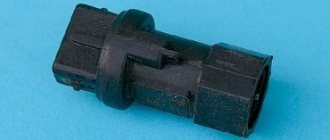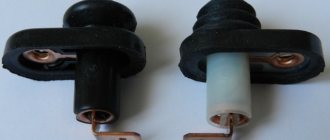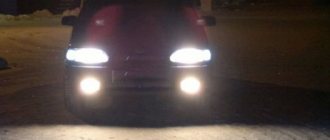If any electrical circuit fails, the first thing you need to do is check the condition of the fuses and relays. This simple operation can be performed independently. The driver needs to know where the Niva Chevrolet fuse box is located and the purpose of the fuse links installed in it.
Location and electrical diagram
For cars manufactured before 2009
For cars manufactured since 2009
Engine control system fuse box
How to change fuses?
The process of removing and replacing the block
Removing the fuse box for engine management systems
Features of cars with air conditioning
Video “How to change Chevrolet Niva fuses”
Comments and Reviews
Location and electrical diagram
To protect electrical circuits on cars, fuses are used, located in a special mounting block. On a Chevrolet Niva VAZ 2123, this block is located inside the instrument panel, to the left of the plastic steering column cover. In addition to the main unit, the Chevrolet Niva has an additional unit that is responsible for the operation of the car’s engine. This safety element is located in the passenger compartment and is located on the right side of the instrument panel behind the glove box. The placement of blocks in the cabin is the same for cars of all years of manufacture.
The main blocks of machines are divided into two types - before 2009 and after. These devices are not interchangeable. The blocks behind the glove box are identical in design. On a 2005 car, you can easily install a block from a 2011 car. The designation of the fuse rating is marked on the body; on the assembly itself there is a number of the fuse link and a pictogram of the purpose. There are no fuse markings on the main unit cover.
For cars manufactured before 2009
On cars of the first years of production, a mounting block from a VAZ 2110 passenger car (2110-3722010-01) was used, designed for 8 relays and 20 fuses. Additionally, the device has three standard locations for spare fuse links.
2006 Chevy Niva block (diagram inverted)
Explanation of fuses
The block contains fuses for low-load vehicle circuits. For example, it is there that a 25-amp fuse for the heater fan is installed (position F18) and a 20-amp motor insert for driving the wiper blades (number F9).
Assignment of fuses for Niva Chevrolet 2007
Relay description
The main unit contains relays responsible for the operation of the following electrical equipment:
| Number | Purpose |
| K1 |
Optional relay for monitoring the integrity of machine lamps. On most machines, jumpers are installed instead from the factory.
Several more relays are installed to the bottom of the main unit.
In cars produced in 2008, this relay is:
- turning on fog lights front and rear;
- starting the window motors;
- activation of a warning signal;
- starting the starter.
Depending on the configuration, there may be more or less.
For cars manufactured since 2009
On Chevrolet Niva cars after restyling in 2009, a block of a slightly different configuration is used (2123-3722010).
Block Chevrolet Niva 2010
Description of fuses
The purpose of the fuses on the new units has changed.
Assignment of fuses for Niva Chevrolet 2012
Relay decoding
| K2 | Designed to start the windshield cleaning system |
| K3 | Direction indicators and emergency stop warning system |
| K4 and K5 | Activation of low and high beams respectively |
| K6 | Auxiliary circuits (ventilation system, rear window cleaning) |
| K7 | Heated glass surface on the rear door |
| K8 | Reserve |
| Number | Purpose |
| K1 | Designed to start the windshield cleaning system. |
| K2 | Direction indicators and emergency stop warning system. |
| K3 and K4 | Activation of low and high beams respectively. |
| K5 | Auxiliary circuits (ventilation system, rear window cleaning). |
| K6 and K7 | Heated glass surface on the rear door. |
| K8 | Reserve. |
A part has been added to the additional relay block to turn on the heated seat system.
Engine control system fuse box
The connectors of this KSUD unit can accommodate five relays and five fuses, including a 15-amp protective insert for the fuel pump. The fuel supply pump itself is controlled by a separate relay installed in the same device. The block contains many important elements for protecting the vehicle's electrical circuits. For example, if the fan relay fails, the cooling system will not be able to fully cool the engine.
Power sensor
If various elements in the car do not work, then first of all we begin to look for the fuse that is responsible for this device. This can be easily done if you rely on the information provided above, and take it out of its seat; this can be done with tweezers.
After removal, we carry out a visual inspection of the appearance; if there are no external defects, then we resort to using a tester, switch it to the prozvana mode, and the probes should be placed on the ends of the fuse. If the element is faulty there will be silence, if it is normal, the tester will start making sounds. Once a faulty fuse is found, it should be replaced with a new one designed for the required current value. As you can see, the procedure for detecting and replacing burnt-out elements is not a complicated procedure, and you can do it yourself.
There are two types of car blocks - for those produced before and after 2009. Unfortunately, parts from cars before and after restyling are not interchangeable. But the blocks located behind the glove box have virtually no structural differences. that is why when replacing them, the year of manufacture of the car will not matter.
The protective device may fail due to long periods of use, so if any consumer stops working, the first thing to check is its fuse.
They are held in their nests by sliding contacts. In order to remove the element, simply pull it out of the socket. To make this more convenient, modern mounting blocks are equipped with plastic tweezers.
A faulty fuse can be determined by visual inspection or using an ohmmeter. Since the housings are made of transparent plastic, the integrity of the conductor is easy to determine with the naked eye. In addition, conductor burnout is accompanied by an increase in temperature. Traces of heat exposure remain on the plastic case. Having selected an element suitable for its nominal value, it is inserted into the socket in place of the failed one.
If a fuse burns out on the road, you can replace it with an identical one that protects the circuit of the consumer that is not currently in use.
More information about Chevrolet Niva electronics can be found here.
The ignition relay is located in the passenger compartment fuse box; it can be found on the driver's side of the instrument panel, opposite the seat. On the diagram it is usually designated K6 and in the technical description it is sometimes called an addition relay.
It is responsible for turning on the fuel pump and supplying voltage to other elements. Triggered when the ignition key is turned. At this moment, you can hear a click behind the instrument panel. This electric coil built into the relay receives voltage and closes the contacts of a certain circuit. If there is no characteristic sound when turning the key, this may indicate its failure.
This element is marked K3 in the diagram. It is responsible not only for the turn lamps, but is also activated when the hazard lights are turned on. It has a slightly different structure, unlike K4 and K5, since it has a built-in timer that turns on and off the circuit at a given interval. Thanks to this, it ensures that the lamps flicker.
But if everything is in order with the relay, and the devices do not work, then there may be a problem elsewhere - the mass attachment point. The negative wire coming out of the battery is connected to the car body and goes to some of the main energy consumers in the form of wires. This is sometimes the difficulty when calling an electrician.
The architecture of the circuit can be described as follows: a wiring harness comes out of the negative terminal, connecting devices operating from one ground point, then wires connecting other ground points are connected to them using a crimp sleeve. As a result, finding a specific mass attachment point is quite difficult.
For example, the mass of the mirror control unit is located behind the trunk trim. But with the engine everything is a little simpler. Since it is connected to the frame and body through pads, which are essentially a dielectric, it has its own wiring harness. The terminals are located on the left side of the engine, below the ignition module. They are responsible for the operation of the ECU and ECM sensors.
If, after checking all of the above, you find the reason why the radiator fan does not turn on, you only have to check one wire - the radiator sensor wire. To do this, you must remove the switch as it does not allow access to the fuse box plugs. This means we remove the plug from the fuse block and check the radiator sensor wire for a break.
We check as follows: connect the wire to the “ ” terminal of the battery, install the second end into the connector of the chip. Next, remove the plug from the sensor and connect the light bulb. If there is no light bulb, make a “teal” to ground. If there is no voltage, most likely this wire is broken.
If the fan does not turn on, the reason may be completely unexpected, for example, a burnt gasket under the head. Switching on does not occur for the reason that the coolant does not enter the cylinder, while gases from the cylinder penetrate into the coolant, creating an effect known as an air lock.
WHAT TO DO IF THE RADIATOR COOLING FAN DOES NOT WORK
Problems with the electric motor. If the electric motor fails, its rotor will not spin, and accordingly, the impeller will not rotate. You can check the performance of the electric motor by connecting it directly to the battery. To do this, you will need to take two wires, connect them to two battery terminals and two electric motor terminals.
If the fan does not spin when connected directly to the battery, we can conclude that the electric motor needs to be replaced; Problems with the sensor. If the sensor is unable to detect the coolant temperature and transmit a signal to turn on the electric motor, it will need to be replaced. To make sure that it is not working, you need to disconnect two wires from it and short them together.
If the electric motor starts to spin the impeller, this will indicate that the sensor is faulty and needs to be replaced; There is no tension. The third and most common reason for a non-working radiator cooling fan is the lack of voltage in its power supply circuit. If there is a break in the wires or a fuse fails, the circuit will be de-energized.
RADIATOR COOLING FAN IS NOT WORKING: HOW TO USE THE CAR
Also interesting: Tuning Niva: 145 photos of ideas on how to improve the VAZ 2121 with your own hands "
Try turning on forced operation of the fan from the battery; If the fan is not forced, you should drive at a constant speed of about 60 kilometers per hour or higher so that the oncoming air flow cools the fluid on the radiator without the help of a fan. It is also recommended to turn on the heating system in the car interior so that some of the heat from the coolant escapes into the cabin.
Technical parameters of Chevrolet Niva (2123) 1.7 / Chevrolet Niva (2123) in a 5-door body. SUV with an 80 hp engine, 5 manual transmission, produced from 2002 to 2009.
The designers of the Chevrolet Niva used a dual fan unit in the cooling system. This slightly complicated the connection diagram, but sharply increased the efficiency of radiator airflow. The fans are driven by 12-volt DC synchronous motors with a permanent magnet inductor. Electric motors have a closed, non-demountable design and do not require maintenance.
The power of each electric motor is 110 W. The fan assembly draws 18 amps.
The fans are turned on one by one using an electromagnetic relay controlled by the on-board computer. When the coolant heats up above 99 degrees, the electric fan located closer to the engine air intake starts. The switch-on temperature of the second impeller is 101 degrees. The fan connection diagram is shown below.
- Voltage is applied to the control terminals.
- Current passes through the inductor, resulting in an electromagnetic field.
- The steel contacts attract and close.
- The current passing through the relay drives the electric motor.
- Disconnect all wires
- Removing the upper pipe
- Removing the bumper
- If there is an air conditioner, bend the tubes (this must be done carefully, as they may burst) or drain the freon (filling it back will not be cheap), then remove the air conditioner radiator.
- You need to loosen the nuts on the radiator casing
- Tilt the radiator so that you can remove the fan unit
- Unscrew the bolts that secure the block and remove it
How to change fuses?
To change the fuse links in the Niva Chevrolet fuse box, you need to understand the electrical circuit of the car. A failed fuse can be identified visually or using a tester. To do this, turn on the device in the closed circuit sound test mode and install the probe tips on the fuse contacts.
Test procedure and tweezers
The replacement itself, for example, a windshield wiper fuse with a rating of 20 A (position F9 on both blocks), is carried out as follows:
- Open the block cover.
- Find the failed insert.
- Take it with tweezers and pull it out of the nest.
- A fuse of the same rating must be installed instead. The use of inserts of a higher rating can lead to burnout of the unit and electrical wiring, as well as to a vehicle fire. Using parts with a lower rating will also not protect the circuit, since such an insert will immediately burn out.
- Turn on the circuit in which the insert was replaced. If re-burnout occurs, then the problem is in the elements of this circuit.
- Place the tweezers in their original place and close the lid.
The process of replacing one of the fuses is shown in the video from the Remgar channel.
Video “How to change Chevrolet Niva fuses”
Another video of replacing fuses and relays on a Chevrolet Niva was shot by Igor Pokhabov.
Chevrolet Niva is a Russian-assembled compact crossover. Produced in 2002, 2003, 2004, 2005, 2006, 2007, 2008. In 2009, the car received a restyling. The updated version was produced in 2010, 2011, 2012, 2013, 2014, 2015, 2021, 2021 and 2018. We will look at a block with Chevrolet Niva fuses and relays with a full description of the presented circuits. Let's show you where the cigarette lighter fuse is located.
p, blockquote 1,0,0,0,0 —>
p, blockquote 2,0,0,0,0 —>
Main block with fuses and relays
This block is located to the left of the steering column and is closed from below with a lid. To get to it, you need to tighten 2 screws, then press the top edge of the cover and gradually free it from all fasteners.
p, blockquote 3,0,0,0,0 —>
p, blockquote 4,0,0,0,0 —>
The block that appears will be held on a special bracket. The fuse diagram itself and the number of elements on it may vary depending on the configuration and year of manufacture.
For cars manufactured before 2009
Scheme - option 1
Scheme - option 2
p, blockquote 6,0,0,0,0 —>
p, blockquote 7,0,0,0,0 —>
Explanation of fuses
p, blockquote 8,0,0,0,0 —>
F1 (5 A) - license plate lamps, instrument panel lamps, indicator light on the dashboard, engine compartment lamp, additional brake light lamp, left side lamps.
p, blockquote 9,0,0,0,0 —>
If any of the listed lamps do not work, check this fuse and the lamps themselves, their connectors and wiring.
p, blockquote 10,0,0,0,0 —>
F3 (10 A) - high beam in the left headlight, indicator lamp for turning on the high beam headlights on the dashboard . Similar to relay K5.
p, blockquote 11,0,0,0,0 —>
F4 (10 A) - backup fuse.
p, blockquote 12,0,0,0,0 —>
F5 (30 A) - front door electric windows and their relays . If, when operating the power window, the window goes down but not up (or vice versa), check the button on the door. When lowering and raising, the polarity and direction of rotation of the motor are different. It could also be a problem with the window lift mechanism. To get to it, you need to remove the door trim. Check that the mechanism does not bite anywhere and that the gears are intact, without broken teeth. If there are problems, you can replace the entire power window drive with a new one.
p, blockquote 13,0,1,0,0 —>
F6 (15 A) - door lock control unit . If one or more doors stop opening, check this fuse. The issue may be in the central locking, control unit, as well as the mechanisms themselves, rods and door locks. If you have no experience, it is better to contact a car service.
p, blockquote 14,0,0,0,0 —>
F7 (20 A) - sound signal and its relay, cigarette lighter .
If the horn does not work, check this fuse, the steering column contacts and the wiring; the contacts may have oxidized and the wiring may have become frayed. Also check the horn itself, you can replace it with another one, for example, a two-tone one from Volga. If the cigarette lighter does not work, check the wiring and its contacts. The white wire is responsible for the backlight, the red and black wires go to the cigarette lighter contacts. Do not insert non-standard connectors into the cigarette lighter, they may cause a short circuit. If the connector in the cigarette lighter moves to the sides, it is better to use a splitter and insert this connector there.
Russia, Penza 2015
Chevrolet Niva is a five-door compact SUV (SUV class) with permanent all-wheel drive.
Produced from 2002 to the present. In 1998, AvtoVAZ presented at the Moscow Motor Show a concept car that was supposed to replace the familiar Niva. The concept received the VAZ-2123 index. In 2006, the rights to the Niva brand were transferred to General Motors. Chevrolet Niva has permanent all-wheel drive - unlike its main “rival” - Renault Duster. The main disadvantages of the Chevrolet Niva are its weak 80-horsepower engine, which provides very modest dynamics, the absence of ABS and a high noise level in the cabin.
- Page navigation
- Mounting block - restyl
- Mounting block - dorestayl
- Fuses and relays KSUD
Fuse box - located to the left of the steering column under the instrument panel. To access the block, you need to unscrew two screws and press down the decorative cover (held in rubber bushings). This car is equipped with two types of mounting block, respectively the doreystyle and restyle versions (see information below).
Chevrolet Niva mounting block (Restyle - model from 2009)
Location of fuses and relays
| F1(5A) | License plate lights, dimensions - left side, engine compartment lamp, side light indicator lamp. Add. brake signal. |
| F2(7.5A) | Low beam (left headlight). |
| F3(10A) | High beam (left headlight), indicator lamp for turning on the high beam headlights. |
| F4(10A) | Left fog lamp. |
| F5(30A) | Power window relay, front door power windows. |
| F6(15A) | Cigarette lighter fuse. |
| F7(20A) | Horn relay, horn, trunk light. |
| F8(25A) | Heated tailgate glass element, heated tailgate glass relay, heated outside rear view mirrors. |
| F9(20A) | Heated tailgate switch, windshield wiper relay, windshield wiper motor, windshield washer pump, right steering column switch, glove box light, reverse light bulbs. |
| F10(20A) | Remote control unit for electrical accessories (door locking) |
| F11(5A) | Side light lamps in the right headlight and right rear lamp, instrument illumination brightness control. |
| F12(7.5A) | Low beam (right headlight), gear motors for the headlight beam controller (electric headlight correctors). |
| F13(10A) | High beam (right headlight). |
| F14(10A) | Right fog lamp. |
| F15(20A) | External mirror control unit, electric drives of external rear-view mirrors, heated seat control unit. |
| F16(10A) | Relay-breaker for direction indicators and hazard warning lights (in hazard warning mode). |
| F17(7.5A) | Interior lamps, anti-theft system status indicator lamp, brake signals, additional brake signal. |
| F18(25A) | Heater fan, heater fuse. |
| F19(10A) | Relay-breaker for direction indicators and hazard warning lights (in turn signal mode), instrument cluster (except for the engine management system malfunction warning lamp), starter relay, air conditioning switch. |
| F20(7.5A) | Rear fog lights, immobilizer, buzzer. |
| K1 | not used |
| K2 | Windshield wiper motor relay |
| K3 | Relay-breaker for direction indicators and hazard warning lights |
| K4 | Low beam relay |
| K5 | High beam relay |
| K6 | Auxiliary relay (Tailgate defroster relay coil, heater fan, windshield wiper and washer, tailgate wiper and washer) |
| K7 | Tailgate glass heated relay |
| K8 | Reserve |
Remote relays (under the mounting block)
| K1 | Fog light relay |
| K2 | Power window relay |
| K3 | Seat heating relay |
| K4 | Horn relay |
| K5 | Starter relay |
Chevrolet Niva mounting block (Dorestayl - produced before 2009. Block from VAZ 2110)
| F1(5A) | License plate lighting. Instrument lighting. Exterior lighting indicator lamp in the instrument cluster. Engine compartment lamp. Additional brake signal lamp. Front dimensions. |
| F2(7.5A) | Low beam (left headlight). Electric headlight corrector (left side). |
| F3(10A) | High beam (left headlight). |
| F4(10A) | Left fog light. |
| F5(30A) | Power window relay and front door power windows. |
| F6(15A) | Door lock control unit. |
| F7(20A) | Horn relay. Sound signal. Cigarette lighter. |
| F8(20A) | Tailgate heated glass relay (power circuit). |
| F9(20A) | Tailgate heated glass switch. Windshield wiper relay. Windshield wiper motor. Windshield and tailgate wiper and washer switch. |
| F10(20A) | Reserve. |
| F11(5A) | Rear dimensions. Instrument lighting regulator. |
| F12(7.5A) | Low beam (right headlight). Electrical headlight adjustment (right side). |
| F13(10A) | High beam (right headlight). |
| F14(10A) | Right fog light. |
| F15(20A) | External mirror control unit. Mirror motors. Heated seats. |
| F16(10A) | Relay breaker for direction indicators and hazard warning lights (in emergency mode). |
| F17(7.5A) | Stop signals. Add. brake lights. Check Engine Light. Interior lighting and individual lighting. |
| F18(25A) | Reversing lamps. Tailgate glass heating relay (winding). Windshield and tailgate washer. Tailgate glass cleaner. Heater electric motor. |
| F19(10A) | Relay breaker for direction indicators and hazard warning lights (in turn mode). Direction indicators in the instrument panel. Direction indicators. Instrument cluster. Indicator lamp on center differential locks. |
| F20(7.5A) | Reserve. |
Also interesting: Niva Chevrolet installation of air conditioning - Auto magazine MyDucato
| K1 | Power window relay |
| K2 | Fog light relay |
| K3 | Heated Seat Horn Relay |
| K4 | Exterior mirror drive relay |
Fuse and relay block of the engine control system (ECS) Chevrolet Niva.
The strip with relays and fuses is located on the ECU bracket. This entire structure is located behind the glove box. To access the fuses, you must remove the glove box.
Additional relay and fuse box
It is located behind the glove compartment at the feet of the front passenger. To access, unfortunately, you will have to remove the glove box. The fuses for the electric fans of the cooling system and the engine control relay (injection system) are located here.
p, blockquote 42,0,0,0,0 —>
Scheme
p, blockquote 43,0,0,0,0 —>
p, blockquote 44,0,0,0,0 —>
Purpose
p, blockquote 45,0,0,0,0 —>
- Additional relay (turns on the right electric fan through an additional resistor at low rotation speed);
- Fuse (50A) protecting the power circuits of the additional relay and the right electric fan relay;
- Fuse for the fuel pump (fuel pump) (15A), protecting the power circuits of the electric fuel pump relay;
- Fuse (15A) protecting the constant power supply circuit of the controller;
- Right electric fan relay;
- Left electric fan relay;
- Electric fuel pump relay;
- Main relay;
- Fuse (50A) protecting the left electric fan circuits;
- Fuse (15A) protecting power circuits switched on by the main relay;
- Controller
Cigarette lighter fuse
If the cigarette lighter does not work, then the first thing you should check is the socket itself for the presence of foreign objects and the integrity of the fusible link, which opens the circuit if the reverse mechanism of the cigarette lighter spiral does not work.
p, blockquote 46,0,0,0,0 —>
p, blockquote 47,0,0,0,0 —>
Next, check the fuse on the unit itself. On the diagrams it is marked as number 6 (F6).
p, blockquote 49,0,0,0,0 —>
If this does not help, then the question remains with the electrical wiring itself.
p, blockquote 50,0,0,0,0 —>
In this video you can clearly see an example of how to get to the fuse box and replace them.
p, blockquote 51,0,0,0,0 —>
What is a relay and why is it needed?
The starter relay is fundamentally different from the retractor. After all, the second mechanism allows you to save the gear and not damage the starter itself in advance. The starter relay is an electronic device with a direct connection to the power circuit. With the help of this mechanism, the circuit is closed and opened. The principle of operation of the relay directly depends on the speed and frequency of rotation of the crankshaft.
In general, the following purposes of this device can be distinguished:
- unloading on the ignition contacts is carried out by a relay;
- prevents accidental sticking of contacts;
- The relay cuts off power to the starter if the ignition key continues to attempt to turn on the starter while the engine is running.
As you can see, this mechanism is simply necessary for stable and long-term operation of the starter. Therefore, the device must work correctly and uninterruptedly. It is not uncommon for clear contact to weaken due to high electrical current consumption during vehicle operation. It is in the interests of the car owner to promptly detect and fix the problem, which is why it is so important to know where exactly the starter relay is located in VAZ 2110, VAZ 2114 and Niva Chevrolet cars.
System structure and principle of turning on fans
Everything works as follows.
- The radiator and engine block are looped into a single system using pipes. Between them there is a rheostat - a damper with a temperature-sensitive element inside.
- When a certain temperature is reached, the damper opens and the liquid begins to circulate in a large circle.
- If passive cooling fails, the engine temperature rises. The head cooling fans come into play. When the temperature limit is overcome, the DTOZh sends an impulse to the BC.
- The processed signal closes the relay and the fan turns on. To improve system performance, the devices are paired. Dubbing helps prevent overheating if one of the devices breaks down. At the same time, the connection diagram for active coolers implies their simultaneous and separate activation.
The Chevrolet Niva interior heater fan is also used to cool the engine. Part of the system has a slight effect on the temperature, but in an emergency it can affect the operation of the engine.
Where is the starter relay located?
To get to the mechanism in a VAZ 2110 car, you need to completely remove the starting device. To work, you will need keys 8, 13 and 15. With this tool you can easily dismantle the starter, on which the relay itself is located. To successfully complete all the work, you need to be patient and persistent. No specific knowledge is required. The operating procedure is very simple:
- The negative wire is disconnected, then the battery is disconnected.
- After which the air filter is dismantled.
- All wiring going to the relay is disconnected.
- Use a 13 wrench to loosen the power cable, after which use a 15 wrench to loosen the nuts securing the starter to the car body.
After that, the starter is removed from the engine compartment, and the fastening bolts are unscrewed with a 8 key.
All work on reinstalling the relay and the starter itself is carried out in the reverse order.
On a Chevrolet Niva car, the relay is located behind the upholstery, under the additional fuse box. The dismantling process consists of releasing the screws and disconnecting the block. The work of reinstalling the starter relay is performed in the reverse order.
Correct installation and disabling of the immobilizer on a Chevrolet Niva
To install an immobilizer, the owner of a Chevrolet Niva or specialists in this field carry out specific actions in a certain sequence. Here are the main stages of immobilizer installation:
- freeing access to the intended installation location of the security device and for laying wires;
- installation, securing and masking of the main system unit;
- laying the necessary wires and connecting them to specific systems - if the immobilizer is not contactless;
- installation of blocking relays or radio sensors - depending on the type of immobilizer;
- connecting an LED light bulb in the cabin - if it is installed correctly, it will definitely light up;
- programming and training of the immobilizer according to the indicators provided by the instructions.
Only the owner of the vehicle should know where the immobilizer is located. If you need to disable it completely, you can use the following methods:
- using a chip from the immobilizer key, which can be taped to the device’s antenna with electrical tape;
- a special code number is entered on the dashboard;
- use of killers, crawlers, emulators;
- installation of a special computer program to disable the immobilizer on a Chevrolet Niva.
The first two methods of disabling are the simplest, but the latter requires special knowledge and skills. Independently disabling the immobilizer, which prevents the car from starting, is a rather complex process that requires knowledge of programming principles. If a person does not have confidence that he will carry out this process efficiently on his own, it is better if he finds the time and opportunity to contact specialists.
Common causes of relay malfunctions
If the starter relay begins to work intermittently or completely fails, then the first thing, after dismantling the mechanism, it should be examined for defects. This extremely important mechanism in the engine starting system can fail for various reasons. The cause may be oxidation of the wires or loose fastenings. Often a break occurs in the electrical power circuit. In any case, if the relay breaks down, then it is necessary to carefully examine the entire starting system for faults.
Advice. Do not repair the starter relay yourself. A faulty device can completely damage the engine starting system. If it fails, the broken mechanism is replaced with a new one.
When choosing a new device, it is recommended to pay attention only to certified products from official dealers. Today in the automobile market you can find a lot of different fakes. Such devices will not last long; the quality of their work leaves much to be desired. Experts recommend installing a four-pin relay with additional metal ears. This will extend the life of the device. It is recommended to choose between 30A and 40A for a four-pin relay.
Recommendations for using the starter
To make your starter last longer, you need to follow a few simple recommendations:
- If you turn on the engine, then this should be done no longer than 15-20 seconds, and repeated no earlier than after 25-30 seconds. If after three times the engine does not start, you need to check the ignition and power system. If such faults are detected, they must be corrected.
- Do not use the starter to move the vehicle. This puts a lot of stress on the trigger mechanism.
- If you have successfully started the engine, turn off the starter, as the overrunning clutch may jam due to frequent rotation of the starter drive gear by the flywheel.
Anyone who has already removed and installed the starter at least once is unlikely to want to do it a second time. Although this work is not difficult, it requires a lot of effort and sometimes money. Follow these simple rules to avoid such breakdowns.
There is a special offer on our website. You can get a free consultation with our corporate lawyer by simply submitting your question in the form below.
